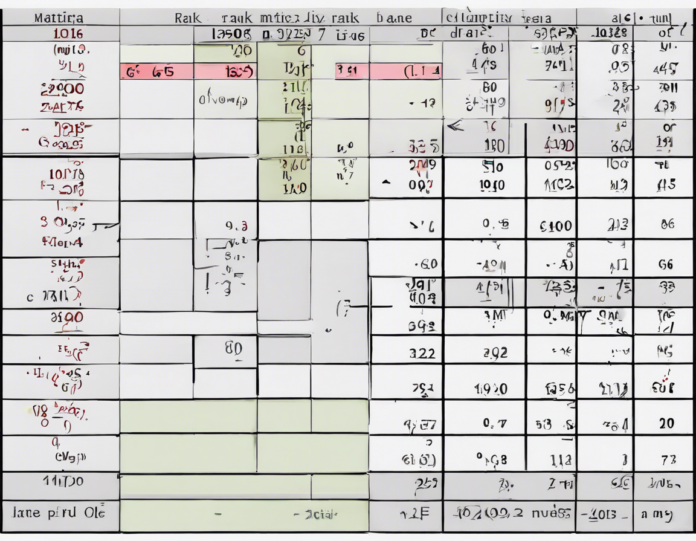Matrices are an essential concept in mathematics and have extensive applications in various fields such as physics, engineering, computer science, and economics. One fundamental property of a matrix is its rank, which plays a crucial role in determining the properties and solutions of linear systems of equations. In this comprehensive guide, we will delve into the concept of the rank of a matrix, its significance, methods of computation, and its applications in real-world problems.
What is the Rank of a Matrix?
The rank of a matrix is defined as the maximum number of linearly independent rows or columns in the matrix. In simpler terms, it represents the dimension of the vector space spanned by the rows or columns of the matrix. Mathematically, if a matrix has ‘m’ rows and ‘n’ columns, then the rank of the matrix is denoted by ‘rank(A)’ and is at most equal to ‘min(m, n)’.
Significance of the Rank of a Matrix
The rank of a matrix provides crucial information about the matrix and its properties. Some of the key significance of the rank are:
-
System of Linear Equations: The rank of a matrix determines the number of independent equations in a system of linear equations. A system of equations can have a unique solution if and only if the rank of the coefficient matrix is equal to the rank of the augmented matrix.
-
Invertibility: A square matrix is invertible (i.e., has an inverse) if and only if its rank is equal to the number of rows/columns. In other words, a square matrix is invertible if it has full rank.
-
Null Space and Column Space: The rank of a matrix is related to the dimensions of its null space and column space. The difference between the number of columns and the rank of the matrix gives the dimension of the null space (kernel) of the matrix.
Methods to Compute the Rank of a Matrix
There are several methods to determine the rank of a matrix, depending on the form of the matrix and available tools. Some common methods include:
-
Row Reduction: One of the most widely used methods is to perform row reduction operations (Gaussian elimination) on the matrix to obtain its row-echelon form. The rank of the matrix is then calculated as the number of non-zero rows in the row-echelon form.
-
Column Reduction: Similarly, one can perform column operations to reduce the matrix to its column-echelon form and determine the rank based on the number of non-zero columns.
-
Determinant Approach: For square matrices, the rank can also be computed using the determinant method. The rank is equal to the order of the largest non-zero minor in the matrix.
-
Singular Value Decomposition (SVD): SVD is a powerful tool to decompose a matrix into its constituent parts and can be used to determine the rank by inspecting the singular values.
Applications of the Rank of a Matrix
The rank of a matrix finds wide applications in various fields, some of which include:
-
Control Theory: In control systems engineering, the rank is used to determine controllability and observability of a system.
-
Computer Graphics: In computer graphics and image processing, the rank is utilized in techniques like image compression and feature extraction.
-
Statistics and Machine Learning: Techniques like principal component analysis (PCA) and linear regression rely on the rank of the data matrix for dimensionality reduction and model fitting.
-
Optimization: In optimization problems, the rank is essential in determining the convexity and solvability of the optimization model.
Frequently Asked Questions (FAQs) about the Rank of a Matrix
- What is the rank-nullity theorem?
-
The rank-nullity theorem states that the sum of the rank and nullity of a matrix is equal to the number of columns of the matrix.
-
Can a matrix with zero rows have a non-zero rank?
-
No, a matrix with zero rows will always have a rank of zero since there are no linearly independent rows.
-
Can two matrices with the same rank be equal?
-
Yes, two matrices with the same rank can be equal, but equality of rank does not imply equality of matrices.
-
Is the rank of a matrix the same as the determinant of the matrix?
-
No, the rank of a matrix and its determinant are two different concepts. The rank is related to the linear independence of rows/columns, while the determinant is a scalar value associated with square matrices.
-
Do all matrices have a unique rank?
- Yes, every matrix has a unique rank, which is a well-defined property based on the linear independence of its rows or columns.
Understanding the rank of a matrix is fundamental in various areas of mathematics and its applications in diverse fields highlight its importance. By grasping the concept of rank and its computational methods, one can gain valuable insights into the properties of linear systems and matrices, leading to advancements in problem-solving and optimization strategies.









